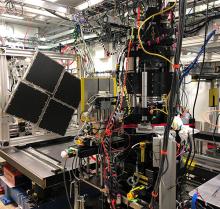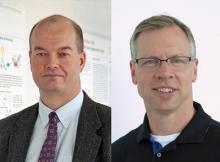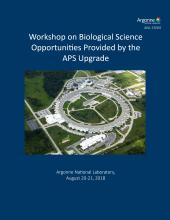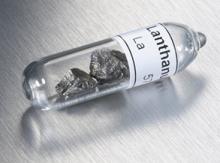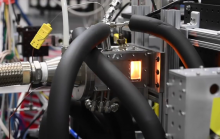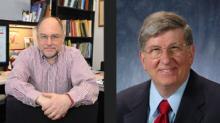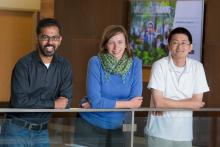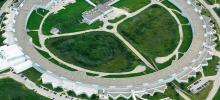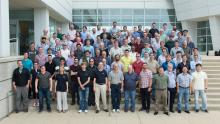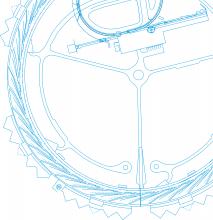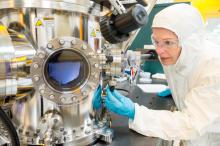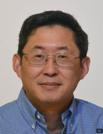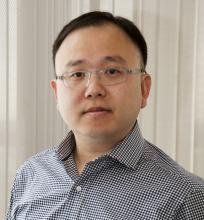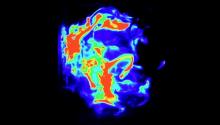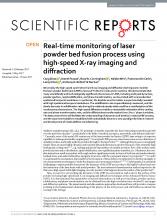News Feed - APS/User News
The 2019 APS/IIT XAFS Summer School was successfully held July 7-12, 2019. The school takes place annually at the Illinois Institute of Technology’s main campus in Chicago, Illinois, and the Advanced Photon Source at Argonne National Laboratory.
Four members from the Metals Branch at the Materials and Manufacturing Directorate, Air Force Research Laboratory (AFRL) were designated as an Air Force Office of Scientific Research (AFOSR) STAR Team for the years 2019-2021 based upon experiments conducted at the Advanced Photon Source and at the Cornell High Energy Synchrotron Source at Cornell University.
The goal of replenishing and strengthening the management team of the Argonne X-ray Science Division in the Advanced Photon Source has been achieved with the appointment of Dean Haeffner as Associate Division Director for Beamline Development, and Alec Sandy as Associate Division Director for Beamline Technologies.
Light filters through large windows at Claire Zurkowski’s apartment, where she sits at her loom, weaving bright yellow-orange thread into a rug already filled with the colors of the rainbow. Her works are inspired by the refraction patterns of the crystals she studies as a graduate student in geophysical sciences at the University of Chicago.
The report on the “Workshop on Biological Science Opportunities Provided by the APS Upgrade” held at Argonne on August 20-21, 2018, is now available.
Physicists working at the U.S. Department of Energy's Advanced Photon Source think they have achieved one of the most coveted goals of their discipline: creating a superconducting material that works at near-room temperature.
Imaging and measuring the atomization process in a gas turbine combustor using the bright x-rays from the U.S. Department of Energy’s Advanced Photon Source has been chosen by RDECOM Research Laboratory, the Army's corporate research laboratory under the Army Research Laboratory (ARL), as one of the 2018 top 10 “coolest” advances.
Brian H. Toby and Robert Von Dreele of the U.S. Department of Energy’s Advanced Photon Source at Argonne National Laboratory have been selected as the recipients of the American Crystallographic Association 2019 Trueblood Award.
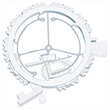
Deadline for submission: Friday, Oct. 26, 2018
The Advanced Photon Source (APS) is seeking user science proposals and requests for beam time on existing proposals.
David Keavney of the Argonne National Laboratory X-ray Science Division at the U.S. Department of Energy’s Advanced Photon Source has been awarded an American Association for the Advancement of Science Science & Technology Policy Fellowship (STPF) with a placement at the U.S. Department of State, Bureau of Energy Resources.
Argonne National Laboratory will be taking over the operations management role for the High-Pressure Collaborative Access Team (HP-CAT), at Sector 16 of the APS currently filled by the Carnegie Institution for Science, effective later this month. The sponsor will continue to be the U.S. Department of Energy National Nuclear Security Administration.
Three Argonne National Laboratory researchers, including one from the X-ray Science Division (XSD) at the U.S. Department of Energy’s (DOE’s) Advanced Photon Source, have earned the DOE’s 2018 Early Career Research Program awards.
The deadline for APS proposals and beam-time requests for cycle 2018-3 is Friday, July 6, 2018, 11:59 PM Chicago time.
The APS hosted the June 2018 EPICS Collaboration Meeting, an international conference of users and developers of the EPICS Control System software tool-kit.
As the APS Upgrade Project (APS-U) moves forward, we want to reach out even further to scientific communities and leaders in order to involve them with beamline upgrade projects, and motivate them to prepare for more challenging experiments. Hence, the APS-U will organize a series of scientific workshops in 2018-2020.
The Center for Nanoscale Materials (CNM) is soliciting proposals for user-initiated nanoscience and nanotechnology research. The CNM provides users with access to a broad range of capabilities for design, synthesis, characterization, and theory and modeling in order to significantly advance the understanding of nanoscale phenomena and develop functional nanoscale systems. Access is provided at no cost to users for research that is in the public domain.
Yang Ren, a physicist with the X-ray Science Divisio at the U.S. Department of Energy’s Argonne National Laboratory, joins eight colleagues and co-authors as winners of the American Iron and Steel Institute “2018 Institute Medal” for their paper “Deformation Mode and Strain Path Dependence of Martensite Phase Transformation in a Medium Manganese TRIP Steel.”
The 2018 Gopal K. Shenoy Excellence in Beamline Science Award was awarded on May 7th, 2018, to Hua Zhou, a physicist in the Surface Scattering and Microdiffraction Group of X-Ray Sciences Division at the Advanced Photon Source.
The U.S. Army Research Laboratory's Center for Unmanned Aircraft Systems Propulsion made an historic first with its experiment in a gas turbine combustor using x-rays at the U.S. Department of Energy’s Advanced Photon Source. The data will help advance gas turbine engine designs for higher power density and efficiency, scientists said.
The paper “‘Real-time monitoring of laser powder bed fusion process using high-speed X-ray imaging and diffraction” (Cang Zhao et al., Sci. Rep. 7, 3602-1-3602-11 (2017). DOI: 10.1038/s41598-017-03761-2) received 1079 article views in 2017, placing it as one of the top 25 highly read papers (out of more than 4500 materials science papers) for "Scientific Reports" in 2017.


